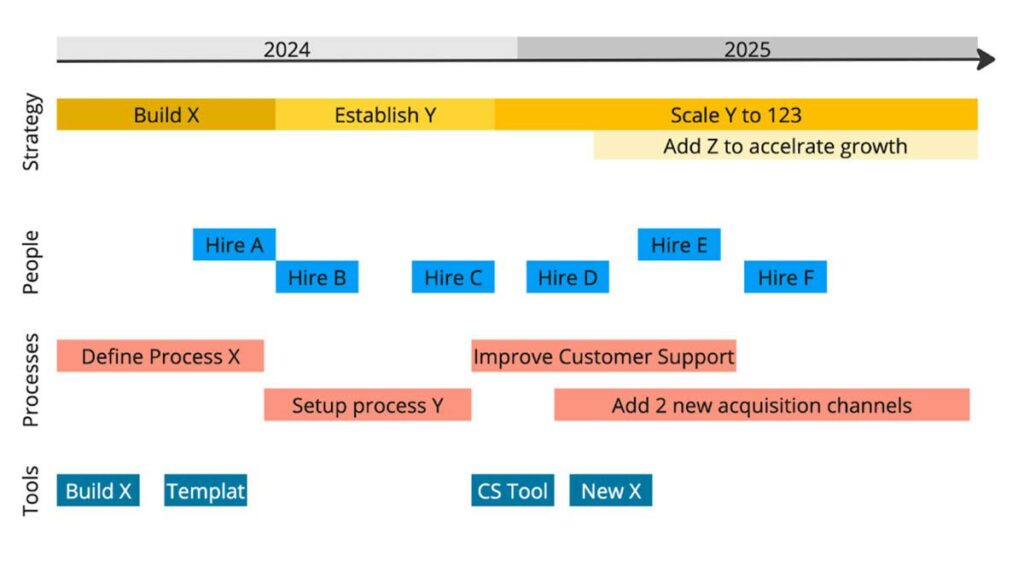
Achieving your business goals is hard. Here’s a 4-step process that allows you to do it anyway.
The four steps of great strategy execution are:
- Define your long-term vision and goals
- Create a strategic roadmap
- Break your goals down into actionable 90-day plans
- Implement regular tracking and accountability
Why most businesses fall short of their goals
There’s a number of reasons why it’s so hard to achieve your goals. Here are the four most important ones:
Lack of Clarity
If you don’t know where you’re going, success will be solely based on luck.
As Seneca said: If one does not know to which port one is sailing, no wind is favorable.
What’s more, it’s not enough to know where you’re going. You also have to decide what the best way is to get there.
No action plans
Even if you know where to go and how to get there, you need to translate this into tasks for your team. If you try to do it alone, you won’t get far.
No accountability
If you change your mind on your business’ priorities on a quarterly basis, you will never reach any goal. Success takes time. If you don’t hold yourself accountable to the plan you have developed, you won’t reach the goals.
No transparency
If you don’t know whether you’re actually making progress, being disciplined becomes even harder. If you don’t know what to measure to determine whether you’re reaching your goals, you’ll have a hard time getting there.
Now, let’s look at what you can do to make it work.
Define your goals

The first step is to be clear about your goals.
Defining your goals
You might want to start with your vision statement. The vision statement describes the future state you want to achieve. That could be for your company, society or anything else.
It that’s too abstract, your goal can really be anything that is meaningful to you.
There are two school of thoughts around crafting effective goals:
Smart Goals
The scientific way is to formulate SMART goals:
- S for SPECIFIC: You want your goal to be measurable.
- M for MEASURABLE: You want to have a goal that’s measurable, so you can track progress towards it and know when you have reached it:
- A for ACHIEVABLE: You want to set realistic goals that you can realistically achieve if you execute your plan well.
- R for RELEVANT: Your goals need to mean something to you and your business.
- T for TIME-BOUND: Each goal needs to have a clear timeline, or better: deadline.
And then, there’s a not-so-scientific way of setting goals that a good number of self-made millionaires advocate for: Large goals.
Large Goals
Large goals work in the exact same way as SMART goals, with two differences: They discard the A (ACHIEVABLE) component in favor of setting large, super-exciting goals,
And the T (TIME-BOUND) is optional.
The rationale behind it is:
It will take effort to achieve any goal, small or large. Why not set a goal that you’re really excited about.
Another angle: If you fail on a Large Goal and accomplish only half of it, you’ll still be more successful failing here than if you had reached a modest, conservative goal.
Which way is right for you depends on your level of discomfort you’re willing to endure and how long a time horizon you’re willing to consider.
Write your goals down
Regardless of which way of goal definition you use, the most important part is:
Put your goals in writing.
Only a spelled out, written down goal will help you actually get there.
How many goals should I have
I recommend keeping the number of goals as small as you can. One goal is fine, 3 is still good, 5 is too many.
Defining your roadmap

Now it’s time to convert your static goal into something you can take action on.
Gap analysis
In the next step, you want to look at where you are today with regards to you goal dimensions.
If your goal is to have 1 million dollars ARR (annual recurring revenue), you want to look at where you stand with this today.
If your goal is to have 1,000,000 in profit, you need to look at your profit today.
If you want to work 30 hours or less per week as the CEO of your business, than have a look at how much you currently work.
This will give you the starting point.
The difference between where you are today and what your goal is is the gap you need to bridge.
Defining the approach to bridge the gaps
Once you have identified your gaps. you’ll have to come up with a way to close them.
There are different tools to do this.
The Math Path
If you’re happy with your current business model and believe it can carry you to your goal, then the math path might be worthwhile exercise.
I first heard the term math path from Grant Cardone, but it’s a simple concept I’ve intuitively applied throughout my entrepreneurial career.
Break your goal down into factors.
An example:
If you’re selling a service at 500 USD a month to 10 clients, your yearly revenue is 500 x 10 x 12 = 60,000 USD. If your goal is to get to 1,000,000 in revenue, then you have a few options.
- Sell the service to 167 clients for the same price
- Double the price and sell to 84 clients
- Sell for 2,000 per month to 42 clients
Or tackle it from the other end:
- Sell to 10 clients, but charge 8,300 USD
- Sell to 20 clients but charge 4,150 USD
You get the idea.
The point is to think through different option to generate your target revenue.
Brain Writing
Another option is brain-writing. I first heard about it in “The New Psychology of Achievement” by Brian Tracey.
The concept is simple:
Take a blank sheet of paper and write down 20 different things you could do to get to your goal.
The first few action items will come to you easily. But it’s important to do 20, to get the creative juices flowing.
Select the best options
Now comes a critical step. Select the strategic options you want to go for.
This is a very qualitative exercise, but here are a few things to consider:
- Market: Is the market that this strategy uses growing or in decline?
- Skills & Talent: Do you or your team already have the skills and knowledge it takes to do that thing? How easy is it to find people who can do it?
- Client access: Do you have access to the clients you’d be selling to already?
- Scalability: Is this option scalable, so could potentially even help you grow beyond your current goals?
- Investment; Do you have to invest lots of upfront cash to make it work?
- Entry-barrier: Is it difficult to do that things you’re planning to do (and will it be for potential future competitors)?
- Risk: How likely are you to succeed?
Map the steps to execute the chosen strategy
Now let’s create your roadmap.
Create a visual timeline in a tool of your choice, e.g. Powerpoint, Google Slides or Miro.
Choose the time frame that you have formulated your goals for. If you smart goal has a deadline of 1 year from now, this is the timeline of your roadmap.
If your goal does not have a timeline, you’ll need to pick one now.

Next, think through the steps you need to take and the intermediate results you need to accomplish to execute the chosen strategy.
Important: There’s no one right solution. There will typically be multiple ways to success. Try to come up with a logical, sequential path that feels natural and doable for you.

Next, still on this high-level, think through the implications of your strategy on your three operational dimensions:
- People: Who would you need to hire, who would you need to partner with? How do you have to upskill, and what do you have to learn personally to accomplish this step on your roadmap?
- Processes: What processes do you need to establish? Which of your current processes will have to change to accommodate the strategy.
- Tools: What tools will you need to execute this step in your strategy? Which of your existing tools will need to go, be replaced or updated? What new tools will you need to build or buy?

Now you have a high-level roadmap.
As a next step, let’s develop the action plans to bring the roadmap ot life.
Set up recurring 90-day action plans
Your roadmap sets strategic direction, but it does not tell you what to do today.
You have to break it down further.
And you need to let your team know what to do next.
A proven method to do this are 90-day action plans. 90 days are short enough for detailed planning to make sense, but long enough to actually get stuff done.
The most popular methodology to set these plans are Objectives and Key Results. So let’s use a simplified version of this framework here.
Setting company level objectives and key results (OKR)
First, you need to define what’s most critical for your business on a company level, for the next 90 days.
Define 2-4 objectives you want to achieve in the next 90 days.
The objectives can be qualitative or quantitative, and should be ambitious but realistic.
Objectives specify what you want to achieve.
Next, you want to define 2-3 key results for each of your objectives.
Key results tell you what you need to accomplish on the way of achieving your objectives.
The key results need to be formulated in quantitative or yes/no way. It needs to be unambiguous whether or not you have reached them.
You want to set them in a way where you will achieve around 70% of them on average. If you always achieve or over-achieve your key results (and with them your objectives), they’re not challenging enough.
The time horizon for these objectives and key results is 90 days.
Developing your departmental OKRs
Now that you have defined what’s strategically important for you on the company level, you need to cascade that down for your team.
In a joint session, derive department OKRs from your company level OKRs.
If your team is small, these might already be personal OKRs.
If you have departments in your company, derive OKRs per department. They are then broken down to the individual level by initiatives (mini-projects to accomplish the key result).
A few considerations:
- There is no 1:1 relation between the company level OKRs and the department OKRs
- All of your company level OKRs should be reflected in the department OKRs (top-down)
- Departments might have additional OKRs that are not part of your company level OKRs (bottom up)
The most important part about the OKR process:
The process and the outcomes should be visible to everyone in the business.
The session in which you develop the departmental OKRs should be an all-hands meeting.
Once set, they have to be visible to everyone.
OKRs are a tool to align teams on strategic priorities, so there is absolutely no point in being secretive about it.
Also, OKRs should be used for performance reviews or bonus calculation, as this would by nature force the team to be more secretive about it.
Accountability and Transparency
Now you have your goals for the next 90 days, that will bring you closer to your long-term goals. You have broken that down into actionable items for everyone in the team.
Now comes the hard part: Doing the work.
Set up tracking
You can set up your OKRs in your task management system. Many modern tools have goal functionalities that allow you to do that.
You can add your current values for the Key Results and update them regularly.
Any tool that allows you to monitor if you’re making progress towards your 90 day goals will be helpful.
Stay and hold your team accountable
The more important thing is to keep yourself and your team on track.
Regular Check-ins
Meet regularly to discuss progress. The frequency largely depends on your team’s maturity and decision-making authority.
A very experienced team that has decision-making power can work much more autonomously on their OKRs. Checking in once every quarter on goal progress might be enough.
If your team is more junior and they don’t have decision-making authority, you will have to move much more often, potentially even weekly. The goal for these meetings would be to jointly remove roadblocks.
Changing priorities
Another common problem we see in strategy execution are changing priorities.
There are two major reasons:
Firstly, once goals are set, something in your business or your surroundings changes. Forcing you to recalibrate.
It’s important, to not discard your goals at this stage, but determine how the change might be incorporated into your goal.
Secondly, your 90 day goal might include some testing of a certain kind: Offers, channels, processes, etc. You might learn in these tests that you were wrong about the projected outcome, forcing you to change what happens after.
In this case, try to find next steps in the spirit of the original OKR.
You will continuously learn and refine your approach of setting OKRs.
It’s simple but not easy
Reaching your strategic goals is very simple. Choose the right goals, and then steadily progress towards them.
In reality, it’s not easy to do that consistently.
A framework like the above might help you to stay on track and realize where you’re off-track.